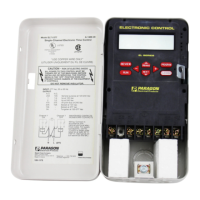Problem: Erratic Temperature Readings
Probable Causes:
■
Thermocouple Lead Wires Attached to Wrong Terminals or Too
Close to Other Wires
■
Thermocouple Lead Wires Touch at Bare Ends
■
Electrical Noise
■
Poor Electrical Circuit Ground
■
Defective Relay or Transformer
■
Defective Thermocouple
■
Thermocouple Touching Metal Case of Kiln
Even though protected by insulation, the thermocouple
wires are sensitive to electromagnetic waves. Position them
away from other wires inside the switch box. Thermocouple
wires must be attached to the correct terminals. Check that
the thermocouple wire ends are separated where the insula
-
tionhasbeenstripped.Electrical“noise”fromachatteringre
-
layornearbyarcweldingmachinescancauseerraticreadings.
If erratic temperatures display momentarily each time the
relays click on, have an electrician check the electrical circuit
for a poorly connected grounding wire.
Iftheerratic temperturereadingsdisplayonlywhile theel
-
ements are powered, the problem may be a defective relay or
transformer.
A worn thermocouple can cause erratic temperature read-
ings. Wiggle the thermocouple tip. If the temperature jumps
by a wide margin, replace thermocouple.
Problem: Overfire
Probable Causes:
■
Thermocouple Pushed Out of Firing Chamber
■
Stuck Relay
■
Defective Thermocouple
■
Thermocouple Touching Metal Case of Kiln
(Ceramics:usewitnesscones.)Checkthatthethermocou
-
ple is protruding into the firing chamber by at least
1
2
"-
5
8
".
Sometimesbumpingashelfagainstthethermocouplepushes
itoutofthefiringchamber,alteringthetemperaturereadings.
Ifan elementstaysonafter pressingSTOP,a relayisstuck.
Replace the relay. If the temperature reading is over 100°
higherthantheactualtemperature,replacethethermocouple.
Note: a defective thermocouple can read correct room tem
-
perature and be inaccurate at high temperatures.
Make sure the thermocouple, including the spring on the
endofthethermocouple,isnottouchingthekiln’smetalcase.
Problem: Stuck Display
Probable Causes:
■
Stuck Key
■
Electrical Noise
Sometimes a chattering relay or other source of electrical
noisefreezes the displaymessage.Turnoffthepowerforten
seconds.Ifthatdoesnotcorrecttheproblem,returntheboard
for servicing.
Problem: Relay Chatters or Buzzes
Probable Causes:
■
Defective Transformer
■
Defective Transistor on Controller
■
Low Line Voltage
■
Weak Relay
Voltageatcontrollerboardconnectors3and 6shouldbe12
-14voltsDC. Voltageinthe10-11rangemaynotbeenoughto
drivetherelays,ormaycausearelaytochatter.See“Controller
Display Lights Up Normally, Some or All Heating Elements
Do Not Fire,” page 16, to check the board with a voltmeter.
Lowvoltageatconnectors3and6canbecausedbyadefec
-
tivetransformer,adefectivetransistorontheboard,orlowline
voltage. To diagnose the cause, check the voltage from the
transformer at connectors 5 and 7. Correct voltage is 20 - 24
voltsAC. Whenvoltagefallsbelow20volts,theboardwillmal
-
function or will not have enough voltage to drive the relays.
Iflowvoltageisdetectedatconnectors3and6or5and7,re
-
place the transformer.
Problem: Kiln Switch Box Fuse
Blows Repeatedly
Probable Causes:
■
Wrong Fuse
■
Defective Transformer
■
Shorted Relay
■
Defective Controller
Check thefuse in thekiln’s switchbox. The fuseholder is
nearthebottomoftheswitchbox.Removefusebypressingon
the fuse holder and turning counter-clockwise half a turn.
The correct fuse:
AGC ½ A 250V AC
Refer to the diagram on page 22. Disconnect the orange,
whiteandblack wires(#5, 6, 7) fromthebackof board.Apply
powertokiln.Iffuseblows,replacethetransformer.Ifthefuse
does not blow, then the problem is a board or relay.
Connect #5, 6 and 7 wires to the board again. Disconnect
redwire,#3.Applypower.Ifthefuseblows,replaceorservice
theboard.Ifthefusedoesnotblow,theproblemiscausedbya
short in the coil of a relay.
Disconnecteachrelay,oneatatime,untilyoufindtherelay
that blows the fuse.
Problem: Unwanted Beeping Sound
Cause:
■
Alarm Set to 0000
When the controller emits a beeping sound at the begin
-
ningoffiring,thealarmwasprobablysetto0000oratempera
-
ture below room temperature. See “Temperature Alarm,”
page 13.
20

